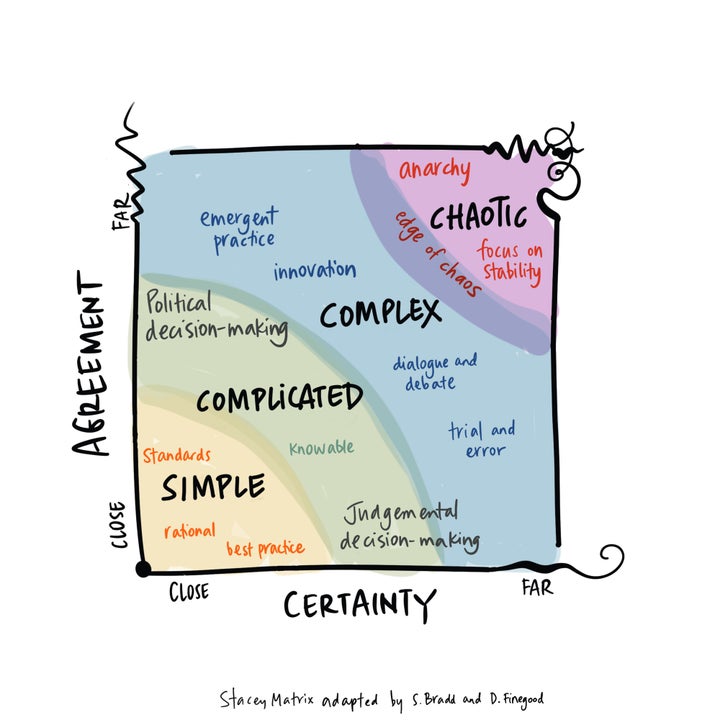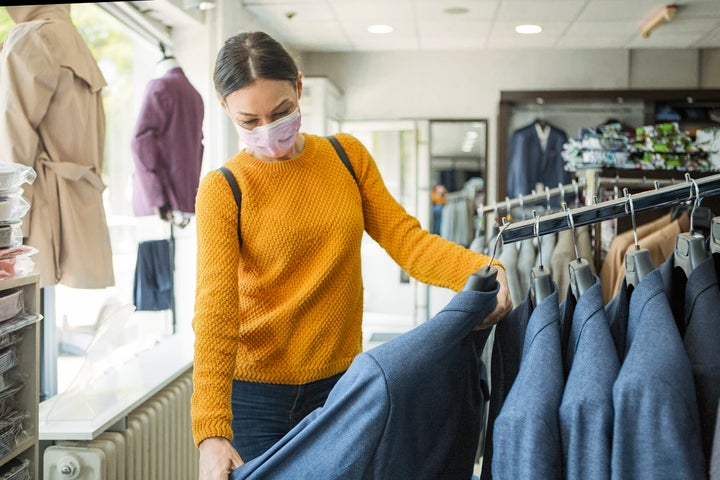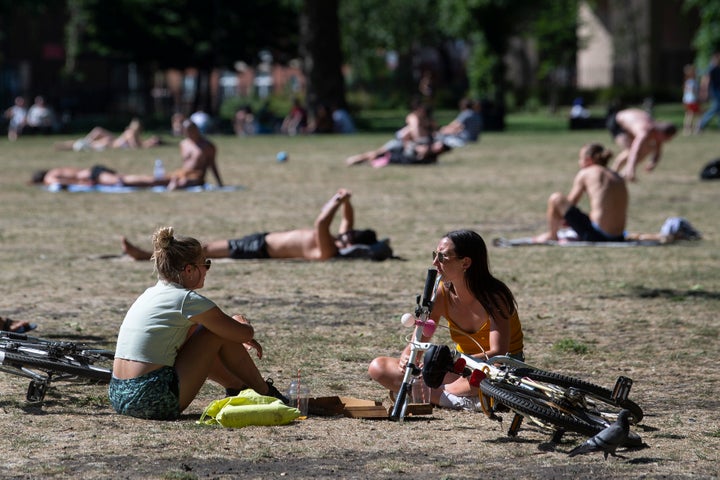
Deciding whether or not to go to the park has never been so complicated.
We’re now past the three-month mark of life under lockdown, and lots of people are starting to get restless. The weather’s nicer, stores and restaurants are starting to re-open in some parts of the country, albeit in limited capacity, and it’s hard to resist the temptation to finally see friends.
Many of us are struggling with how to make decisions on if and how we can interact with people outside of our home unit in this new world. How can we support local businesses without putting ourselves and people in our communities at risk? Is it safe to hang out with friends if we keep a two-metre distance from one another? How do we even go about making these decisions, when there are so many unknowns and the stakes are so high?
“I think for a while, we probably will need to weigh each interaction,” Monika Dutt, a family and public health physician based in Sydney, N.S., told HuffPost Canada. Ask yourself, “What can I do that will allow me to participate in my community in some way, but keep that distance and try to keep the people around me safe?”
Why some decisions are so hard to make
For Diane Finegood, a professor in the biomedical research department at Simon Fraser University in B.C., it can help to weigh these kinds of questions in terms of how certain we are about the information we have, and how widely people agree to follow that information.
Finegood shared a graph from her work with HuffPost to illustrate how and why these questions get more convoluted. Something like hand-washing would fall under the “Simple” category, she said — we all know it’s effective at protecting ourselves from transmission of the disease, and we all know we should do it.
Questions about whether to see friends from a distance are usually either “complicated” or “complex,” depending on a number of variables.

“We don’t know for sure, but the evidence suggests that that level of distancing, being outdoors, is pretty safe,” Finegood said. “The probability of us being within close distance for a long enough time with somebody who could be spreading the disease is much less than if we’re, sadly, singing in a choir for a couple of hours with somebody who is spreading the disease.”
But that gets more complicated if, say, it’s a really nice day and there are more people around than normal. You have less control over that situation, which makes your risk level harder to predict.
The thousands of people who gathered at Trinity Bellwoods Park on Saturday, making Toronto a national laughing stock, is proof enough of that. The sheer number of people who showed up made it virtually impossible for anyone there to socially distance.
None of these questions — can I go on a social distancing walk? Can I see my friends if we’re two metres apart? Should I go into a bar? — have easy, absolute answers. Public health officials can’t say “Yes, socially distanced park hangs are fine,” because that depends on where you live, who’s in your household, what your job is, what your personal version of “staying safe” looks like, and a lot of other factors.
Essentially, there are no simple right or wrong answers.
Questions to ask yourself
When you’re thinking about these questions, you should keep in mind both your personal risk (what harm are you potentially putting yourself and your family in?) and your personal responsibility (what harm are you potentially putting people outside your family in?), Finegood said.
Here are some of the questions to ask yourself when you’re considering whether or not it’s safe to see people outside your home, or to go places, in the age of the COVID-19 pandemic.
What are the local rules?
Checking the updated regulations in your area is an important first step, Dutt said. What’s allowed where varies wildly across the country. B.C. and Alberta are re-opening bars and restaurants. Some national parks are re-opening in June, but not all. These rules are different everywhere and they change often, so make sure you have the newest information from your province or territory’s public health body.
Is it indoors or outdoors?
If you’re going to be around people who aren’t in your “bubble,” or household, it’s a better idea to do that outside rather than inside, Dutt said. “Being outdoors is safer than being indoors, because it’s easier to transmit infection in close quarters without good ventilation.” But even so, it’s important to stay two metres apart from other people, or to wear a mask if physical distancing isn’t possible.
If it’s indoors, do I know what kinds of precautions are being taken?
Many stores, restaurants, and other businesses are using social media to detail what they’re doing to keep their establishments as safe as possible (such as only letting in a couple of customers at a time), or explaining their decisions to wait a little longer before re-opening. Taking that information into account can help you make a safer decision.

And if it’s indoors, am I comfortable giving my medical history to a stranger?
Some businesses that are starting to re-open are doing so with extreme caution. They might take a customer’s temperature, or ask about symptoms they’ve experienced. Others are asking customers to wear masks and to sanitize their hands before coming in.
Not everyone is going to be comfortable with this. If that’s the case for you, maybe you wait a little longer before visiting a store that’s taking those measures.
If it’s outdoors, how many people will be there?
Going to the less-crowded parks in your area where social distancing is possible is a better call than going to the one that’s always super busy. Take into account the time of day and the weather, too.
Do I live or regularly interact with someone who’s elderly or immuno-compromised?
Your health, and the health of those you live with, is a big part of this equation. We know the virus can be harder on older people and people with compromised immune systems, so whether or not there’s a possibility of inadvertently transmitting it to people in those categories — either because you live with them, work with them, or interact with them in some other capacity — is a really important factor to consider when assessing risk.
Will my kids be there?
Inviting friends over to your backyard, if you’re lucky enough to have one, can work under some circumstances. But it can be tricky if kids from different households have to interact without getting physically close to one another.
Kids are a risk factor when it comes to interacting with friends, according the a harm reduction guideline in the LA Times. Depending on their age, it might be really hard for them to understand the concept or follow the rules.
The evidence we have so far shows that kids seem to be less likely to contract the virus than adults. But it’s important to remember that this doesn’t mean kids are immune. Children have died from COVID-19. And, even if they don’t suffer themselves, kids who seem perfectly healthy can be asymptomatic carriers who spread the illness to other people.
How much control do I have over how close I’ll get to other people?
A park where people play frisbee, for instance, might have more accidental physical contact than another outdoor areas. Some stores might limit the amount of people allowed inside more than others. Considering those variables might bring some clarity.
Dutt suggested trying to be empathetic towards people who are making choices different from the choices you would make. Maybe they have less outdoor space than you have, or live alone, or are dealing with other circumstances they can’t change.
“For some people, it’s going to be more challenging than others,” she said. “Other people are likely doing their best with whatever situation they’re in.”
How much do I trust that the friends I’ll see have been following the rules?
Some people are better at following direction than others, and you likely have a sense of that when it comes to your friends. If you suspect they might not take the two-metre rule seriously, or that they haven’t been following other public health guidelines, it may be more of a risk to spend time with them.
Remember that you can’t monitor your friends’ or other family members’ movements, or demand that they take precautions. But you can ask them If they’ve been following social distancing and self-isolation measures, and measure your risk depending on their answer.
Are there extra measures I can take to be safer?
Bring hand sanitizer, disinfecting wipes, and a mask with you to the park and stores, especially if physical distancing isn’t possible. Maybe it makes more sense for you and a friend to sit in your cars than to sit in a park. Consider all your options.

It’s important to remember that there are no right or wrong answers here, and a lot of it hinges on what you’re comfortable with. If a socially-distanced hang just doesn’t feel safe or comfortable to you, there’s no harm in saying, “I’d rather wait.”
And if you’re someone who has trouble making decisions, and you can’t land on a way of feeling safe while seeing people, it can help to just take yourself out of the equation.
If your capacity for complexity doesn’t match the complexity of your environment, you can always just bow out, Finegood said. (She’s pretty sure she has a graph for this, somewhere, too.) There’s no shame in saying no, in having a nap or taking a bath or doing something else to calm yourself down, “saving that capacity for more complex challenges in your life,” she suggested.
The best we can do, Dutt said, is consider the risk, consider the benefit, and do what makes the most sense to us.
“In the end, people need to make their individual decisions about what they feel comfortable with.”
Also on HuffPost: